AMD Radeon HD 7970 GHz Edition Review: Battling For The Performance Crown
by Ryan Smith on June 22, 2012 12:01 AM EST- Posted in
- GPUs
- AMD
- GCN
- Radeon HD 7000
Compute Performance
Shifting gears, as always our final set of performance benchmarks is a look at compute performance. As we saw with the launch of the GTX 680, Kepler (GK104) just doesn’t do very well here, thanks in part to NVIDIA stripping out a fair bit of compute hardware and memory bandwidth on GK104 in order to focus on gaming performance. OpenCL performance is particularly bad with NVIDIA almost completely ignoring it, but even DirectCompute performance often swings AMD’s way. This isn’t to say that GK104 doesn’t have its moments, but when it comes to compute it’s typically AMD’s time to shine.
Our first compute benchmark comes from Civilization V, which uses DirectCompute to decompress textures on the fly. Civ V includes a sub-benchmark that exclusively tests the speed of their texture decompression algorithm by repeatedly decompressing the textures required for one of the game’s leader scenes. Note that this is a DX11 DirectCompute benchmark.
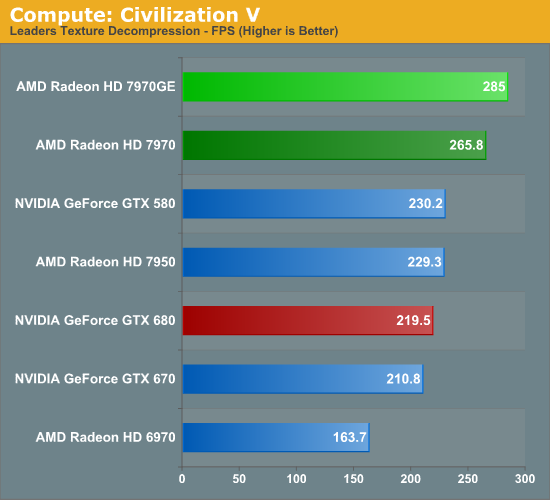
The 7970 already had a significant lead in this benchmark thanks to AMD’s work on improving their DirectCompute performance, and the 7970GE extends it further. The most important factor of course is actual game performance – where the 7970GE and GTX 680 are tied – but this is clear software evidence of what we already know in hardware: that the 7970GE is far more potent at compute than the GTX 680 is.
Our next benchmark is SmallLuxGPU, the GPU ray tracing branch of the open source LuxRender renderer. We’re now using a development build from the version 2.0 branch, and we’ve moved on to a more complex scene that hopefully will provide a greater challenge to our GPUs.
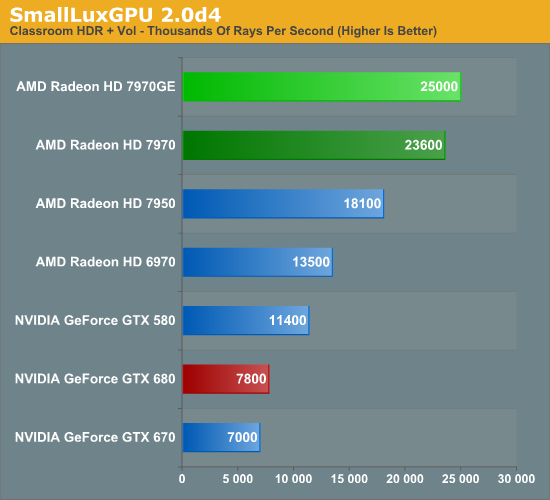
Being an OpenCL title that NVIDIA isn’t taking any care to optimize for, the 7970GE simply blows the GTX 680 out of the water. It’s not even a contest here. Only one card family is even worth consideration for use here. However it’s interesting to note that the 7970GE’s performance improvement over the 7970 is a bit below average, with the 7970GE only picking up 6%. SLG does stress memory bandwidth and compute performance, but in all likelihood the 7970GE isn’t boosting as much here as it is under our gaming tests. Once AMD starts exposing real clockspeeds we’ll need to revisit this assumption.
For our next benchmark we’re looking at AESEncryptDecrypt, an OpenCL AES encryption routine that AES encrypts/decrypts an 8K x 8K pixel square image file. The results of this benchmark are the average time to encrypt the image over a number of iterations of the AES cypher.
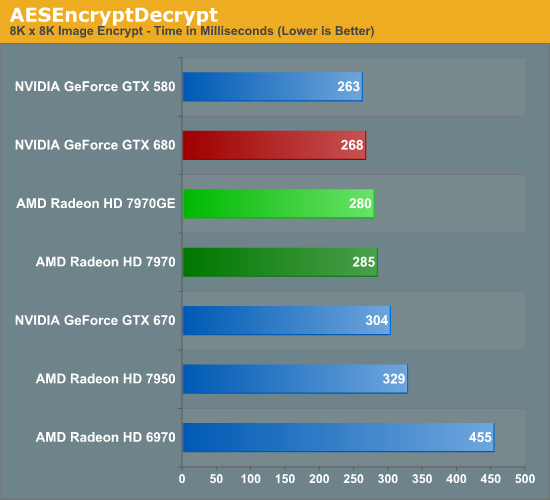
While the 7970GE does improve upon the 7970’s already strong performance, we’re clearly reaching the point where the relatively long CPU/GPU transfer times over PCIe are taking their toll, explaining why the 7970GE could only shave off 5ms. This is actually an important point to make and is why APUs are so important to AMD’s GPU computing plans, but it also means that at a certain speed GPU performance ceases to matter.
Our fourth benchmark is once again looking at compute shader performance, this time through the Fluid simulation sample in the DirectX SDK. This program simulates the motion and interactions of a 16k particle fluid using a compute shader, with a choice of several different algorithms. In this case we’re using an (O)n^2 nearest neighbor method that is optimized by using shared memory to cache data.
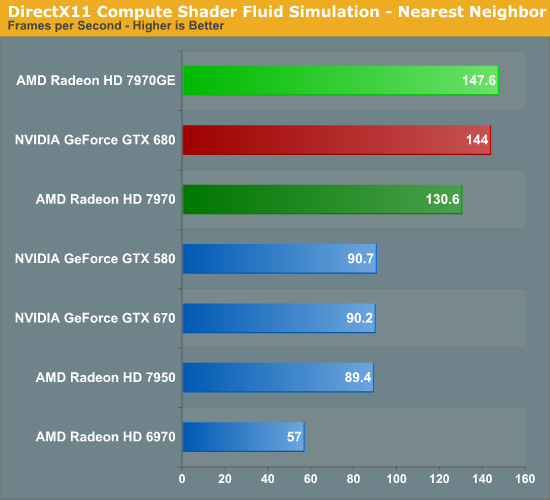
In this final compute shader benchmark NVIDIA’s performance is actually quite respectable, leading to them besting the 7970. However the 7970GE provides just enough of a performance boost to push AMD ahead of NVIDIA here, giving AMD a solid majority of our standard compute benchmarks. Even when Kepler is faced with a favorable workload, it looks like GCN based 7970GE is capable of taking NVIDIA head-on.
Finally, we received a number of requests for some further compute benchmarking using some of the consumer programs AMD provided the press with for the Trinity launch. In particular WinZip and handbrake were requested, so we’ve gone ahead and run those benchmarks for this review.
Starting with WinZip, WinZip 16.5 introduced OpenCL acceleration of both compression and AES achieve encryption. Despite being accelerated via OpenCL WinZip only supports AMD devices, presumably because only AMD provided technical assistance. As a result we’re looking solely at pure CPU performance and GPU accelerated performance across AMD’s lineup.
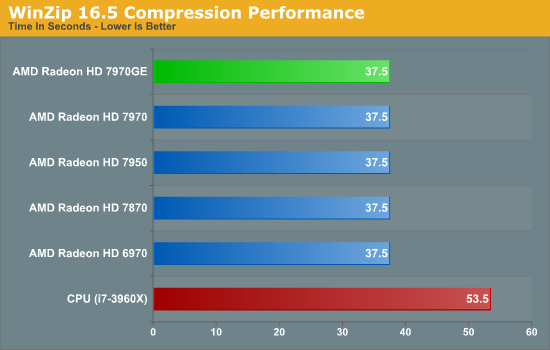

One thing immediately sticks out: WinZip isn’t very sensitive to GPU performance. Merely having a GPU increases performance rather significantly, but it doesn’t matter if it’s a fast GCN card or a GCN card at all for that matter, as even the VLIW4 based 6970 returns the same times. In fact AMD’s drivers report almost no GPU load, so it’s questionable how much of this is actually being run on the GPU versus being run on the CPU through AMD’s OpenCL CPU driver.
As for Handbrake, AMD sent along a newer version that works with discrete GPUs. AMD notes that this is still very much a work in progress, which we saw first-hand when OpenCL acceleration failed to handle two of our three test clips. It failed to properly crop one video, and failed to properly detelecine another. Handbrake’s OpenCL acceleration will of course continue to improve as it approaches release, but for the time being it’s definitely a beta.
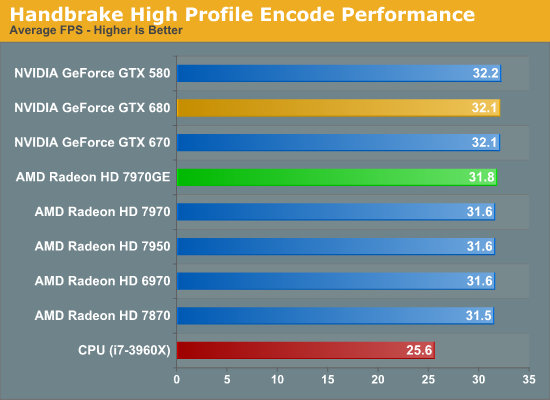
Much like WinZip, Handbrake doesn’t appear to be particularly GPU performance sensitive, which doesn’t come as much of a surprise. Large parts of the H.264 encoding process are ill suited for GPU acceleration, so X.264 is only offloading part of the process and the deciding factor is still CPU performance. The actual GPU load is very inconsistent, but generally tops out at around 40% usage.
The end result is nothing to sneeze at however. Whereas Handbrake averaged 25.6fps without GPU acceleration, with it performance increases by 24% to around 32fps. And unlike other GPU compute accelerated encoders the quality here is very consistent between the CPU and GPU paths (though GPU file size tends to be a bit larger), which means we’re retaining the same quality and customizability of Handbrake/x264 while gaining additional performance for free.
Despite the fact that this is an AMD backed initiative it’s interesting to see that Handbrake’s performance isn’t heavily reliant on the GPU being used. We would have assumed that Handbrake was only optimized for AMD’s GPUs at this point, and even if that’s the case NVIDIA’s GPUs are still fast enough to make up the difference. The fact that Handbrake performance with NVIDIA’s GPUs is a hair faster is not at all what we would have expected, but at the same time this is very beta quality software and is likely dependent on the clip being used, so we wouldn’t advise reading too much into this at this time.










110 Comments
View All Comments
Belard - Friday, June 22, 2012 - link
Agreed.Articuno - Friday, June 22, 2012 - link
A whole new card launch and yet another pair of similarly named but differently performing products because they changed a few numbers that anyone can in several free, easily available programs.I suppose they can do this because you can actually buy their products though, unlike the 6XX series.
ExarKun333 - Friday, June 22, 2012 - link
Yeah, tough to find 6xx products indeed. There is something called the 'internet' you could check out. Your buddy who posted for you might be able to help you out. ;)Pantsu - Friday, June 22, 2012 - link
I doubt any AIB will actually release GE cards with reference cooling. Most likely they will be custom cooled, so the loudness of the reference card is a bit of a moot point.It's good to see some decent driver improvements from AMD. I'm still quite happy about 7970 performance at 5760x1080, and it's enough for most games when OC'd. It would be interesting to see though, whether the GE has improved the max OC. Most likely it's no better though, and you'll be better off buying an old custom 7970 for a good price and OC'ing it to the same levels as the GE.
dagamer34 - Friday, June 22, 2012 - link
The GE chips are better binned parts, one would assume that they have a bit more room for higher clocks than the normal 7970 parts. Certainly the average overclock will be higher.CeriseCogburn - Saturday, June 23, 2012 - link
So we can deduce that the prior 7970 overclocks were sucking down an even larger amount of enormous electrical power as those chips are of lower bin.I guess we need an overclocked power suction chart with an extended table for the amd housefire 7970.
Any savings on card price or a few frames at a resolution near no one owns will be gobbled up by your electric bill every month for years - save 1 watt or 9 watts at extended idle, but when you game it's 100+ watts and beyond with the overclocked 7970 - maybe they should be $300 with 3 games.
silverblue - Monday, June 25, 2012 - link
Well, it works both ways. You won't always be gaming, in addition there's all that compute hardware that, if properly harnessed, would save you money over competing solutions because you'd get the job done quicker. It used to be pointless to consider using anything for compute that wasn't a Quadro, Tesla or even FirePro, however those days are coming to an end.Having a 7970 will make sense for compute if that's your bag (there's a reason for the die size plus the extra memory and bus width), but this time, NVIDIA enjoys a performance/watt advantage which might go unchallenged for a while. Unless, of course, that extra hardware on the 7970 is properly leveraged; future games, perhaps?
ltcommanderdata - Friday, June 22, 2012 - link
So do we think this will encourage nVidia to release a GeForce GK110 based product in the next few months rather than restrict it to Tesla?PsiAmp - Friday, June 22, 2012 - link
Nvidia isn't holding GK110 in its sleeve waiting for something. It is unfinished in the first place and there's no manufacturing capacity to produce such a large chip. Nvidia still struggles to fix GK104 design to have good yields. GK110 would be impossible to produce in since it is twice bigger and such will have at least 4 times less yield.Server market is not only much more profitable, it is operating on a contract basis. Nvidia will start to produce Tesla K20 in Q4 2012.
IF(?) desktop card based on GK110 will hit the market it won't be sooner than Q1 2013. And it is not something that you can change really.
silverblue - Friday, June 22, 2012 - link
"Of course this isn’t the first time we’ve had a hot & loud card on our hands – historically it happens to NVIDIA a lot – but when NVIDIA gets hot & loud they bring the performance necessary to match it. Such was the case with the GTX 480, a notably loud card that also had a 15% performance advantage on AMD’s flagship. AMD has no such performance advantage here, and that makes the 7970GE’s power consumption and noise much harder to justify even with a “performance at any cost” philosophy."Very true, however the power consumption and heat difference between the 5870 and the 480 was definitely more pronounced.
The 680 is an incredible card, no doubt about it. It may not win in some titles, but it's hardly anywhere near unplayable either. AMD being right there at the very high end is fantastic but unless titles truly make use of GCN's compute ability, the extra power and noise are going to be hard to swallow. Still, I'd own either. :P